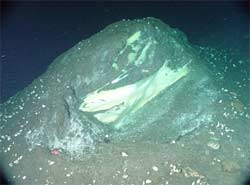A remote drilling rig high in the Mackenzie Delta has become the site of a breakthrough that could one day revolutionize the world's energy supply.
For the first time, Canadian and Japanese researchers have managed to efficiently produce a constant stream of natural gas from ice-like gas hydrates that, worldwide, dwarf all known fossil fuel deposits combined.
"We were able to sustain flow," said Scott Dallimore, the Geological Survey of Canada researcher in charge of the remote Mallik drilling program. "It worked."
For a decade now, Dallimore and scientists from a half-dozen other countries have been returning to a site on Richards Island on the very northwestern tip of the Northwest Territories to study methane gas hydrates.
A hydrate is created when a molecule of gas – in this case, methane or natural gas – is trapped by high pressures and low temperatures inside a cage of water molecules. The result is almost – but not quite – ice. It's more like a dry, white slush suffusing the sand and gravel 1,000 metres beneath the Mallik rig.
Heat or unsqueeze the hydrate and gas is released. Hold a core sample to your ear and it hisses.
More significant is the fact that gas hydrates concentrate 164 times the energy of the same amount of natural gas.
And gas hydrate fields are found in abundance under the coastal waters of every continent. Calculations suggest there's more energy in gas hydrates than in coal, oil and conventional gas combined.
Getting that energy to flow consistently and predictably, however, has been the problem. Using heat to release the gas works, but requires too much energy to be useful. Researchers have also been trying to release the methane by reducing the pressure on it.
Last month, the Mallik team became the first to use that method to get a steady, consistent flow.
"That went really well," said Dallimore. "We definitely demonstrated that these hydrates are responsive enough that you can sustain flow.
"We were able to take conventional technologies, modify them, and produce. That's a big step forward."
Although countries including India, China, Japan and the United States have undertaken major programs to identify gas hydrate fields, it's the first step in years toward making them productive.
The Mallik well produced fire from ice for six days at a rate lower than conventional gas but about equivalent to a coalbed methane well, Dallimore said.
This year's results prove the basic idea works, he said. The next step is a full-scale pilot project with every consideration that goes into a commercial production rig, including safety and environmental concerns, and questions regarding how much water and sediment are produced per unit of gas.
Dallimore suggests that as conventional natural gas prices increase and supplies diminish, gas hydrates could offer an alternative. They also emit less greenhouse gas than oil or coal.
So far, no Canadian agency is planning a full gas hydrate pilot project.
But Japan is planning one using data from the Mallik project. The United States Geological Survey is trying to start one with other agencies and energy companies.
"Everybody agrees this is what we need to do. It's just (a question of) where," said Brenda Pierce of the U.S. survey. "We're trying to look at doing this on the north slope of Alaska."
Commercial production of natural gas from hydrates is still a few years off, said Dallimore – but perhaps not too far off.
"This stuff may fit into that medium- to longer-term world for North America. For countries like Japan and North Korea, where they have no conventional resources, it may come up quicker."

